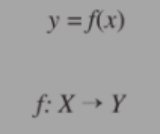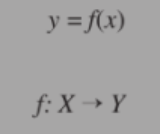Functional Programming
1/48
Earn XP
Description and Tags
Name | Mastery | Learn | Test | Matching | Spaced |
|---|
No study sessions yet.
49 Terms
program
description of a specific computation
function
a rule that associates to each x from some set X of values a unique y from a set Y of values.
domain
The set X is called the ____________ of f.

range
set Y is called the ________ of f.

independent variable
The x in f(x), which represents any value from X
dependent variable
the y from the set Y, defined by the equation y = f(x)

partial function
Sometimes f is not defined for all x in X
total
function that is defined for all x in X
function definition
describes how a value is to be computed using formal
parameters.
function application
a call to a defined function using actual parameters, or the values that the formal parameters assume for a particular computation
In imperative programming, variables refer to memory locations that store values. In functional programming, variables are bound to values and cannot change.
What is a key difference between imperative and functional programming regarding variables?
In mathematics, variables always stand for actual values and do not refer to memory locations or assignments, unlike imperative programming.
How does mathematics treat variables compared to programming?
Imperative Programming (Variables)
variables refer to memory locations that store values, allowing their contents to change over time.
Functional Programming (Variables)
variables are bound to values rather than memory locations. Once assigned, their values cannot change.
Variable in Mathematics
a variable always represents a fixed value and does not refer to a memory location or allow reassignment.
Composition
An operation on functions that takes two functions as parameters and produces a new function as the result.
Higher-Order Function
A function that takes other functions as parameters, returns a function, or both.
Delayed Evaluation
A strategy where function parameters are not evaluated immediately but only when their values are needed.
Applicative Order Evaluation
An evaluation rule where all parameters of a function are evaluated at the time of the function call, regardless of necessity.
Short-Circuit Evaluation
A Boolean evaluation technique where further computation stops as soon as the result is determined, such as in and and or expressions.
Nonstrict Function
A function that can produce a result even when some of its parameters are undefined or contain incomplete data.
Strict Function
A function that requires all parameters to be fully evaluated before execution, making implementation simpler but less flexible.
TRUE
Delayed evaluation allows nonstrict functions to return well-defined results even when some sub-expressions are undefined. TRUE OR FALSE
Lazy Evaluation
A strategy where expressions are only evaluated when their values are needed, allowing efficient computation and handling of infinite structures.
Stream
A partially computed list where elements are generated on demand, enabling the handling of potentially infinite lists in functional programming.
Lambda Calculus
was invented by Alonzo Church (1903 -1995), a mathematician in Princeton University.
Lambda Calculus
It would be a function that takes a single input called x, process it in some way and produces the output, the number x+1 that refers to as increment of x.
purely mathematical function and there’s no internal state that we can look inside a function.
the variables
the lambda notation build functions
a way of applying functions.
Lambda Calculus only got three things, which are:
Lisp
A functional programming language developed in the 1950s–1960s, designed for list processing and based on lambda calculus.
John McCarthy
Developed Lisp
Scheme
A dialect of Lisp that follows the principles of functional programming and is influenced by lambda calculus.
Uniform Representation
Scheme represents both programs and data using a single general data structure—the list.
Metacircular Interpreter
An interpreter written in the same language it interprets, used to define the language itself in Scheme.
Automatic Memory Management
Scheme's run-time system automatically handles memory allocation and garbage collection.
Atoms
are like the literal constants and identifiers of an imperative language, the include numbers, characters, strings, names, functions, and a few other constructs.
parenthesized expression
sequence of zero or more expressions separated by spaces
and surrounded by parentheses
extended Backus-Naur form
This syntax is expressed in a notation called?

Atomic Literals in Scheme
Numbers, characters, and strings that evaluate to themselves without requiring further computation.
Identifiers in Scheme
Symbols (except keywords) that are looked up in the current environment and replaced by their associated values.
Environment in Scheme
A symbol table that stores variable bindings and their corresponding values.
Applicative Order Evaluation in Scheme
A strategy where all sub-expressions are evaluated first, following a bottom-up traversal of the expression tree.
ML (MetaLanguage)
A functional programming language developed in the late 1970s as part of the Edinburgh Logic for Computable Functions (LCF) system.
Edinburgh Logic for Computable Functions (LCF)
A system designed for proving program correctness, which led to the development of ML.
Robin Milner
A key developer of ML and the Hindley-Milner type inference system.
Hindley-Milner Type Checking
A strong type inference system based on pattern matching, used in ML and Haskell.
Haskell
a pure functional language whose development began in the late 1980s, primarily at Yale University and the University of Glasgow. Known for lazy evaluation and advanced functional features.
David A. Turner
A key figure in the development of purely functional lazy languages, leading to the Miranda programming language, which influenced Haskell.
Monads
A mechanism used to handle side effects, such as I/O, in a pure functional programming paradigm.
Layout Rule in Haskell
A rule that uses indentation and formatting instead of explicit syntax elements like semicolons or brackets.